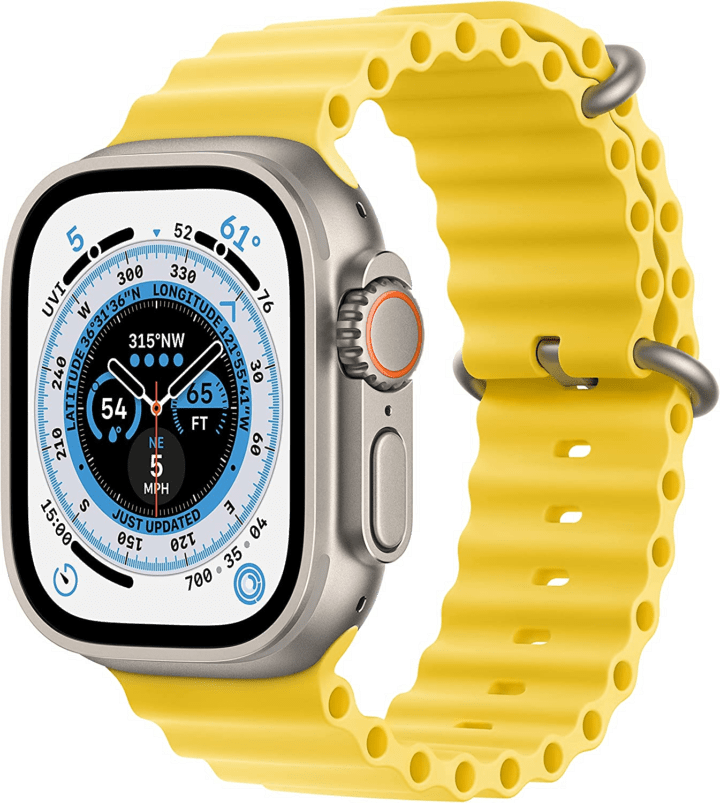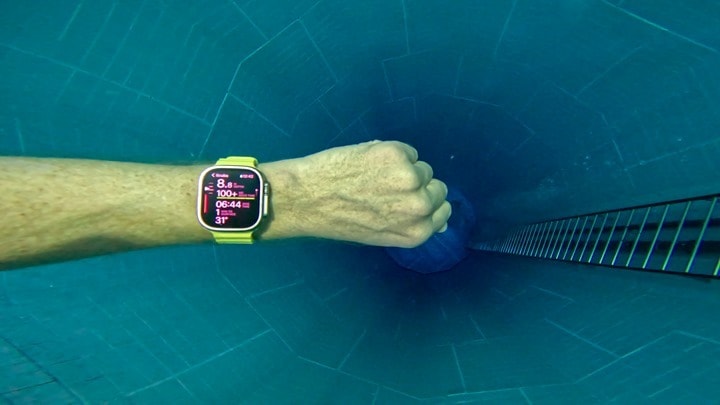
Huish Outdoors, in conjunction with Apple, has today launched the new Oceanic+ dive app for the Apple Watch Ultra. As you may remember, the Apple Watch Ultra has built-in depth gauge hardware that’s certified to 40m/130ft. However, the also built-in Apple app (software) called ‘Depth’ is super limited to just giving you the current depth, and skips most of the dive computer-related features, including important bits like ascent warnings, safety stops, and other safety features.
For that, Apple has partnered with Huish Outdoors, which has its Oceanic+ app. This app has been heavily highlighted by Apple as the closest thing to an ‘official’ Apple dive app that you’ll get, with the two companies working closely together on it – including highlighting it in their annual September keynote. The app has both free and paid versions, including both day-pass and monthly/annual/family subscriptions.
In any case, I’ve been using the app – both in the depth chamber to simulate various conditions (like I did previously with Apple’s Depth app), but also in real life, with a dive last week to see it all in action. In doing so I concurrently compared side by side (well, opposite wrists) with Garmin’s sorta-similar priced Descent G1 ($ 549) dive computer. While both of these units have dive functionality, they also have the rest of their smartwatch features too. One skewed more towards daily smartwatch functions (Apple), and the other skewed more towards endurance watch features (Garmin). This isn’t a comparison post, but I’ll make some notables along the way.
With that, let’s begin.
Quick Features Overview:
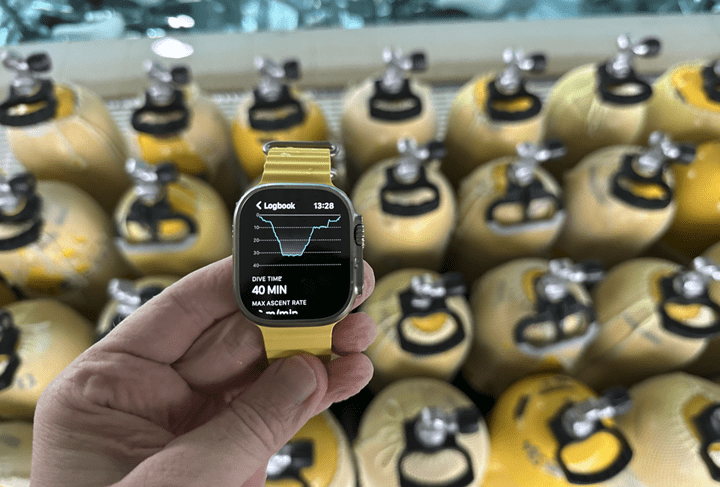
The Oceanic+ app is designed to be a full-featured dive computer. However, what you define as full-featured will probably vary based on your dive skill/certification/goals. The main target audience for this app is recreational divers, or more casual divers. For example, people who dive on vacation once or a few times per year. Or simply those that stay within the depth limits and want online logbook integration. Probably the single biggest gap that you’ll find when comparing the Apple Watch Ultra (or the Garmin Descent G1) to a more traditional dive watch is the lack of air integration. Meaning, it won’t track how much air (or other gas) you have in your tanks. That’s still on you.
And that gets to the second piece. Apple specifically notes that you should “always use a secondary depth gauge and timer/watch”. Which, as a reminder, is what any diver should be doing, and every other watch company states the same. And that’s no different than how 99% of recreational/tourism dives I’ve been on work: They give you the depth gauge as part of your regular gear, as well as a secondary dive computer with depth gauge.
Ok, so what are the core features the Oceanic+ app does have then – see below. They’ve got a giant table on their site that shows what’s free and not free, which I then tried to decode further below.
– Snorkeling/Dive modes
– Shows Depth, Maximum Depth
– Compass and Compass/Heading Lock
– Shows Safety Warnings and Safety Stop
– Ascent rate warnings
– Maximum depth warning(per dive planner, or 40m)
– Cold warnings (per dive planner, or if temp is 0°C)
– Shows Last Dive Time, Elapsed Time, Total Activity Time
– Logbook with dive details, GPS location, total dives, longest dive, pictures deepest dive, etc.
– Adds watch face complications, including no-fly time, time since last dive, etc.
– Decompression info (paid)
– Dive planner – NDL, Max Dive Depth, etc.. (paid)
– Tissue loading (paid)
– Forecasts – Weather/Temp/Tide/UV – (paid)
And then that gets us to pricing. Here’s the official pricing for the paid bits:
– $ 4.99/day
– $ 9.99/month
– $ 79.99/year
– $ 129/year (Family sharing up to 5 people)
When this was first announced, there was a fair bit of ‘variety’ (to put it politely) in how Apple and Oceanic noted the pricing to the press. The numbers varied by who you talked to, and there didn’t seem to be much consistency in whether there was any free mode at all. However, once the dust finally settled, the options are actually fairly reasonable.
Given how much you’re likely to spend on a day of diving at most resorts while travelling, an extra $ 5 isn’t much. Likewise, if you dive far more frequently, then $ 79/year seems reasonable too, primarily if you already had the Apple Watch Ultra and can now use it as your primary dive computer (with typical depth gauge on regular backup).
Obviously, some will point out that you can buy a cheap Cressi model dive computer for $ 230. And sure, you can. Just like you can buy a cheap watch for $ 12 that tells you the time (inclusive of sharks). Both have the core functionality required, but neither have all the advanced features. It simply depends on what you want out of a dive watch. I suspect for most people that are interested in this, it’s again casual divers that already own an Apple Watch Ultra that dive 1-4 times a year at a resort, and simply want that in an electronic logbook. This solves that.
Certifications and Testing:
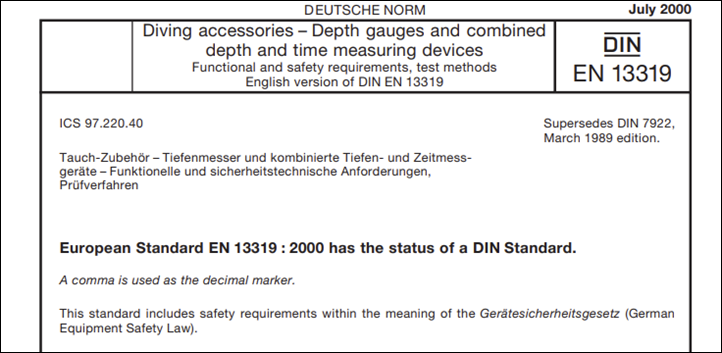
As for the Apple Watch Ultra hardware itself, let’s talk about that and how it’s certified. There are two different components here:
– Water Resistance of the hardware to a minimum of 100m (328ft)
– Certified as EN13319 compliant (dive operation). The Depth app works to a maximum depth of 40m (130ft)
For fun, I spent €58.86 to purchase and download the EN13319 international specifications document. You’re welcome. Within that document there’s a slew of tests that companies do. However, I’ve pulled out the key ones:
– Hammer test (not kidding, there’s an entire ISO document on how to do the hammer test)
– Static force test of 150n pressure while on a wrist fixture
– Pressure test to double the depth pressures*
– Underwater pressure cycling 200 times to 110% of maximum depth of device claim
– Sea water resistance test for 24 hours
– Temperature tests cycling between above and below water temps at intervals from 20°C down to 2°C, and air temps up to 60°C.
– Readability tests, timer accuracy tests, glove tests, responsiveness tests, etc…
But wait, it gets better, there’s actually a specific order of the testing. Failure at any point causes failure of the test. So basically, first you temperature cycle it a gazillion times, then you whack it with a hammer, then you leave it underwater for a day, then press hard on it, then you cycle it 200 times, and on, and on. Again, this has to be done in this specific order:
1) Temperature cycling
2) Shock test (hammer)
3) Sea water resistance (24-hour test)
4) Static force wrist fixture test (150n)
5) Pressure cycling (200 times to 110% of maximum depth)
6) Water tightness test
7) Readability test
8) Accuracy test (inclusive of over-pressure test)
9) Dive timer test
10) Operability test (using gloves to push buttons at depth)
*This is an interesting one, as Apple doesn’t specify if they certified EN13319 to 40m, or certified to 100m. There’s a specific pressure table they have to follow. The nearest value on this predefined table to 40m is 45m, for which they’d have over-pressure tested to 90m. Whereas if they certified to 100m, they’d have over-pressure tested to 200m. There’s an error margin allowed of +10m & –15m. For perspective, this is the exact same certification that Garmin uses on their dive watches, and the same dive certification most companies use.
Realistically, there’s no chance that Apple is going to expose themselves legally here to claiming something that it’s not. They’ve done the actual certifications pieces, so there’s that. And undoubtedly the Apple Watch Ultra can probably withstand far greater than that, though as you’ll see below, it purposefully stops reporting depth below the claimed limit.
Got all that? Good, let’s go diving.
A Test Dive:
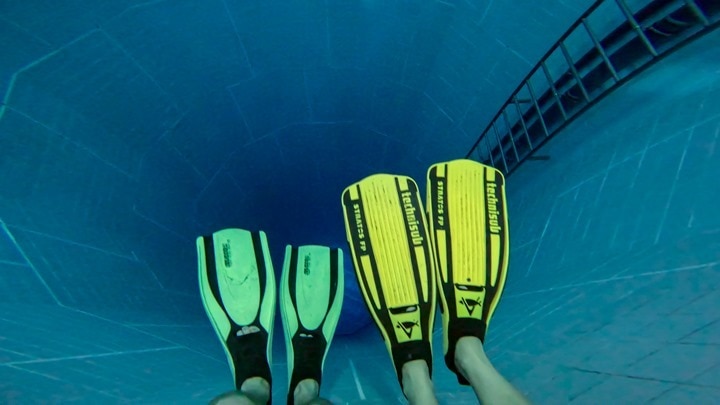
Ok, with the basics out of the way, I headed to Nemo 33, just outside of Brussels (Belgium). I had previously wanted to go diving here back in September when the Apple Watch Ultra first came out, but was hesitant to rent a car and drive the 2-4 hours, only to find out it’s closed. They don’t maintain their website with their hours, and they fail to answer the phone. However, after a total of 22 attempted phone calls over three days (I’m serious), they finally answered the phone, and I was able to confirm their hours. Albeit, that final time they picked up was after we rented the car, drove a few hours, and were only 25 mins away from the facility.
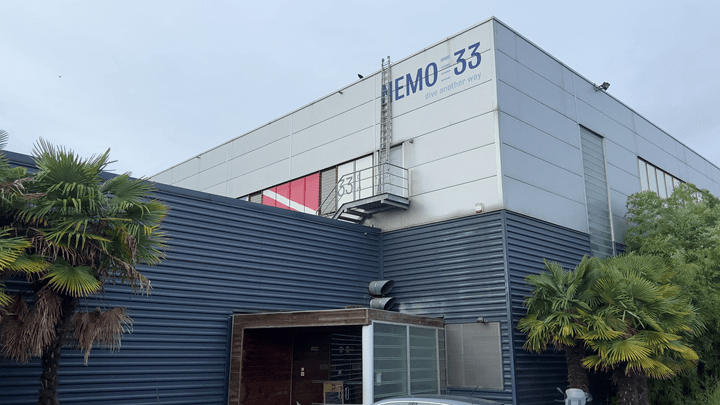
In any event, they were super nice once we managed to get them on the phone – and we basically had the place to ourselves. In case you’re wondering about their hours, I put it below in the FAQ section. It cost us $ 70 total for both of us, and all the gear rental for the hour or so.
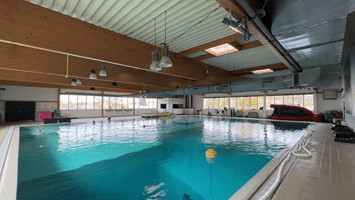
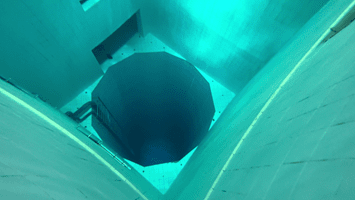
The indoor facility is awesome, and has a depth of 33 meters (108ft), but also interestingly, it is maintained at 33°F (91.4°F). Making it perfect in terms of depth for our tests, but also ideal in terms of not needing a wetsuit. There are also a few different levels/areas of the facility.
Before starting my dive, I configured the settings in a combination of the app as well as the watch (Oceanic+ app). Specifically, I changed my preference to meters/Celsius, but also validated it was set for Scuba, versus snorkel. In this case, I didn’t create a specific dive plan, though we’ll cover that later. The Apple Watch Ultra is configured to automatically open up a preferred app when you go underwater (once it detects depth). By default, that’s Apple’s own ‘Depth’ app. However, it’ll change to the Oceanic+ app once installed. You can change that of course if you want.
In my case, I opened up the Oceanic+ on the watch manually, as I wanted to validate it maintained the Scuba settings, as well as see the transition over so I could show you.
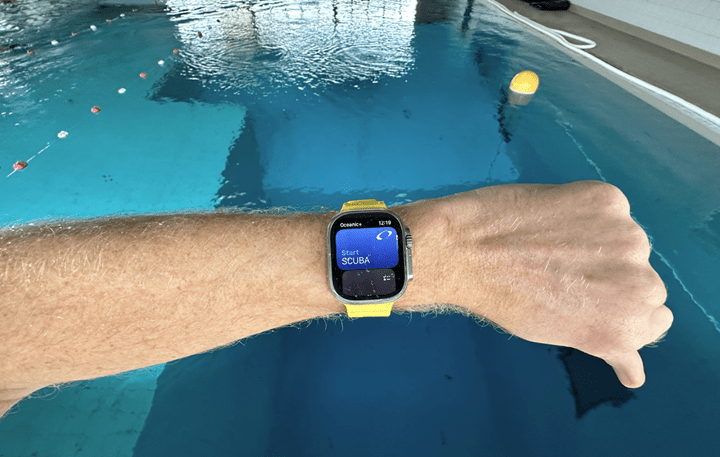
However, you can also set up your dive settings, including air or nitrox, and any alarms you want:
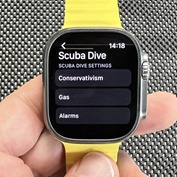
![clip_image001[6] clip_image001[6]](http://media.dcrainmaker.com/images/2022/11/clip_image0016_thumb.jpg)
![clip_image001[8] clip_image001[8]](http://media.dcrainmaker.com/images/2022/11/clip_image0018_thumb-1.jpg)
![clip_image001[10] clip_image001[10]](http://media.dcrainmaker.com/images/2022/11/clip_image00110_thumb-3.jpg)
Had I been diving outside, I could have used the location planner in the app to get weather/tide details for that location. Here’s a spot nearby that I have zero intention on going to today, but hey, maybe on a warmer day I’d be convinced:
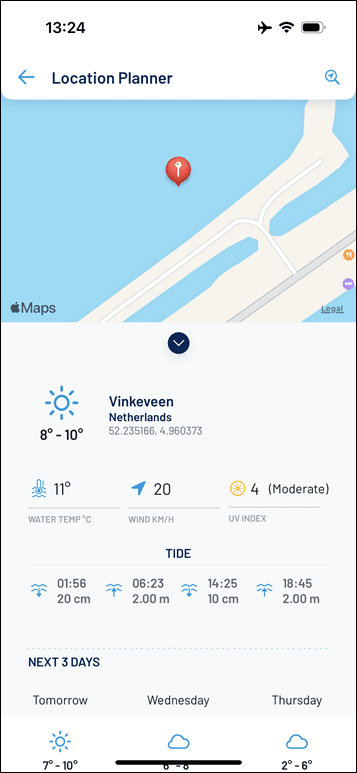
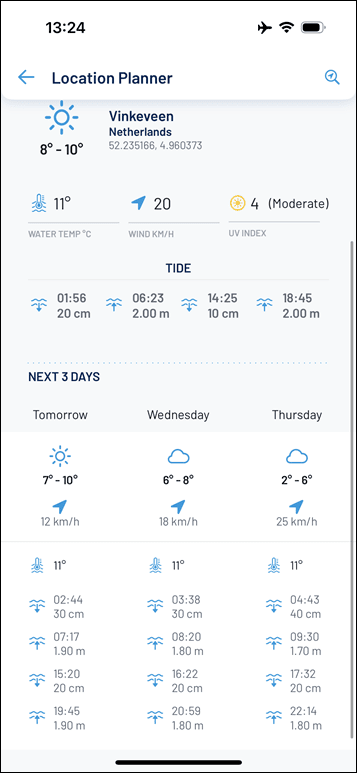
With that set, down I went. I also had started a dive on the Garmin Descent G1 at the same time. I noticed that the Garmin started detecting the start of the dive slightly faster as I descended that first meter or two, and then the Apple Watch Ultra kicked in. This didn’t seem to do anything with accuracy of the depth meter, but rather, the trigger point for when a dive ‘starts’. I suspect Oceanic is trying to avoid the typical scenario where you’ve jumped off a boat, and are now perhaps bobbing on the surface waiting for a group to get ready (not wanting to burn air going down immediately). In this case, I find Garmin tends to trigger if my arm goes down towards my legs. Anyways, this is all just geeky curiosity, ultimately, by the time you descend your own body height, it’s tracking. Note: These two images were taken a few seconds apart in slightly different places.
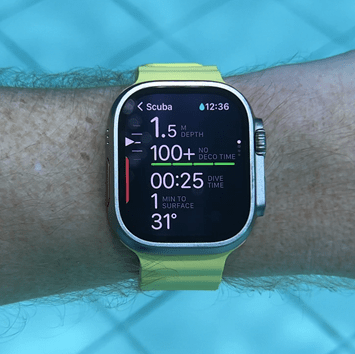
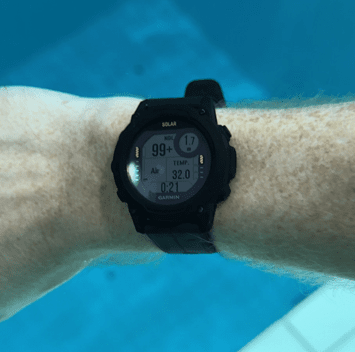
Fun side note: I filmed the first 5 meters or so in depth on an iPhone 14 Pro. I also had a GoPro Hero 11 Black and Hero 11 Black Mini with me. But neither the Hero 11 Black Mini (no dive case) or iPhone 14 Pro would survive the full dive profile. So I left them on a shelf before I descended down the silo. Secondary fun side note: I noticed that Oceanic themselves has an iPhone dive case they’re aiming to start selling in Summer 2023. I’d be totally game to buy something like that, but a price of $ 489 is kinda crazy for a phone case when other dive phone cases are a fair bit cheaper, and launching it during the summer ahead of an annual phone release cycle in September is less-optimal (which probably won’t be compatible with the next phone). Love the idea though, given the quality I get out of my phone these days (also: this comes from someone who has spent thousands and thousands of dollars on underwater DSLR dive cases). Anyways…
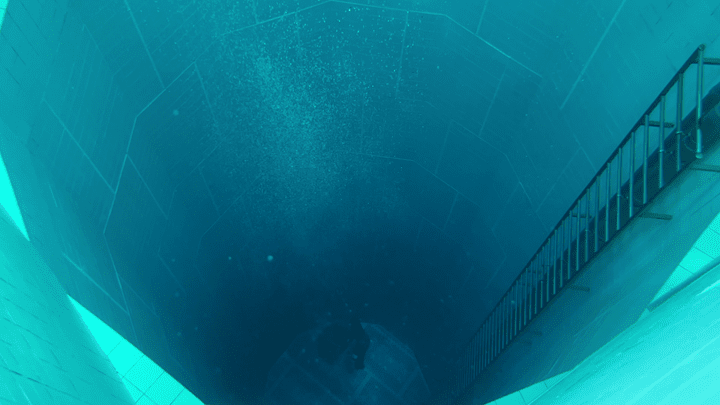
As we slowly descended, the Apple Watch Ultra appeared the track the depth in virtual lockstep to the Garmin Descent G1. They were both identical within 0.5m virtually the entire time.
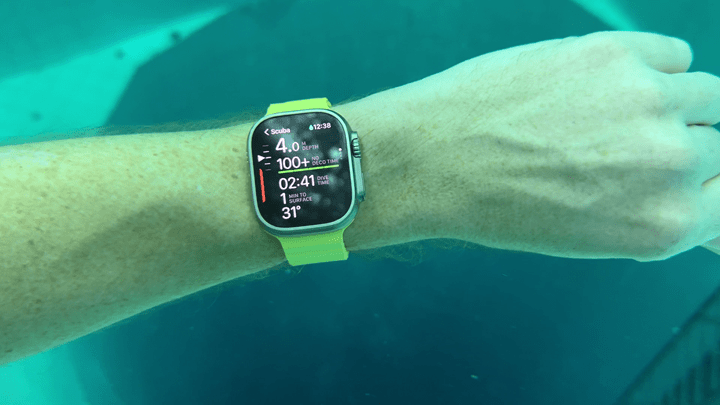
There were some placards placed on the ladder heading down, which had a slight offset to both units of about 0.3-1.0m. Frankly, I’d trust the two dive computers (which also match my reference depth gauge) rather than the rope-connected signs. Here you see 24.4m on the unit, and 25m on the sign connected via rope.

Once we reached the bottom, the depth gauge read 31.7m, and once I put my wrist on the floor, 32.5m. That makes some sense, as the bottom was actually a grate, and then below that about another meter or so was the real bottom, I suppose the actual 33m in depth that Nemo33 has its namesake from.
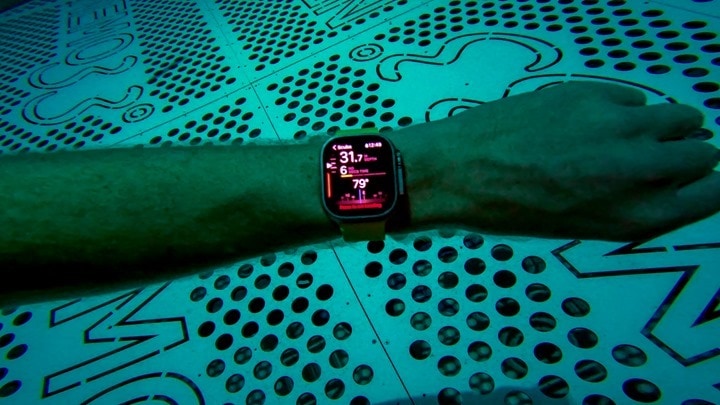
At this point, we kinda just hung out there. The only two other people in the facility with us were already down there playing with a Nerf dart, burning time until they had to ascend. Unlike some openwater locale, there’s not much to do at the bottom of a 33m wannabe missile silo. However, the Apple Watch Ultra kept watch over our time down there, slowly counting down (sorry, the lighting is pretty minimal there, and the GoPro Hero 11 in the dive case isn’t great in low-light):

You can rotate through the different data pages by using the digital crown. There are four screens:
Primary screen: Current depth, no-deco time, variometer, water temp, mins to surface, and dive time
Second screen: Current depth, no deco time, max depth, ascent rate, battery level
Compass screen: Current depth, no deco time, compass heading, compass direction (and ability to lock heading)
Air screen: Current depth, no deco time, gas, max PPO levels, and your dive plan config
One of those data pages is the compass screen. You can hold to set a compass heading, and then it’ll keep tracking using the magnetic compass. Note, there is no GPS underwater.
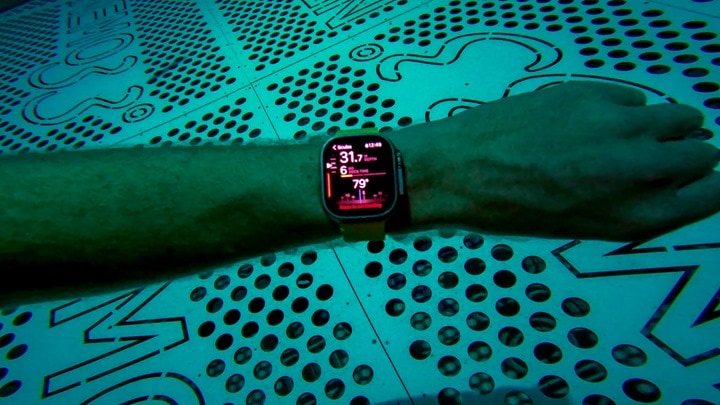
Meanwhile, the Garmin Descent G1 in these low-light conditions is definitely harder to read than Apple’s brilliant battery-blowtorch of a display. However, having done many other dives with the Descent G1 in openwater (overcast and sunny days), it’s perfectly fine in outdoor conditions where the sun is far brighter.
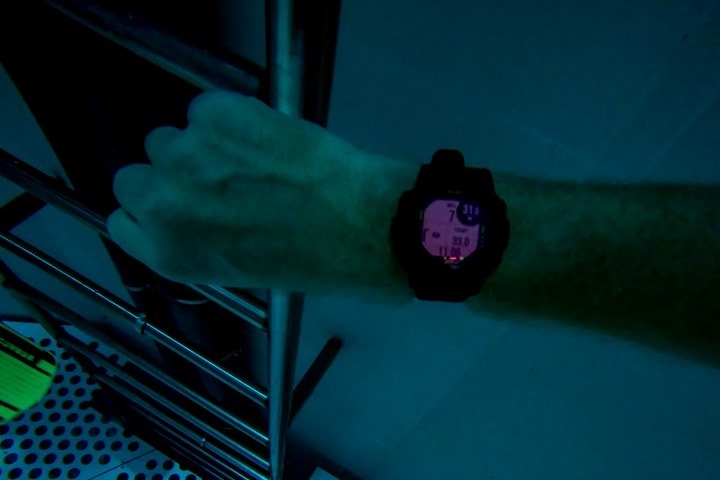
A few minutes later, we reached 0:00 time left if we wanted to avoid decompression stops (No Decompression Limit), and the Apple Watch Ultra, almost to the second with the Garmin Descent G1, alerted us to the fact that we should head up. Both of these are based on the Bühlmann ZHL-16 algorithm, hence why they’d alert at virtually the same moment.
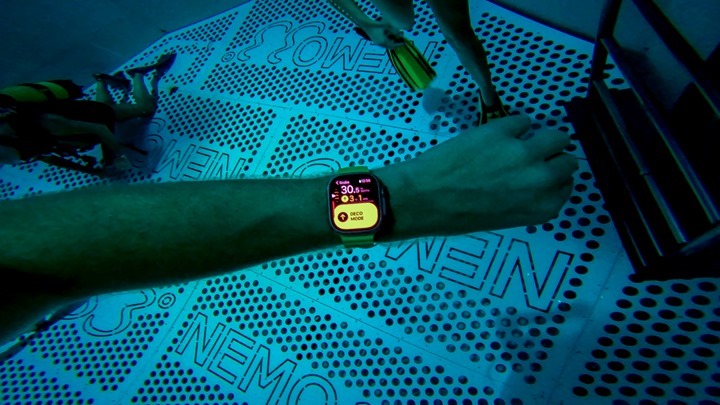
Interestingly, within 30 seconds of that, the two other older guys also started heading up. So whatever they were using (it looked not-fancy) had them on the same timetable. As we ascended it tracked our ascent. Given we didn’t ascend super fast, we didn’t get any ascent warnings (I show that in the FAQ section). As we reached 5m (15ft), it alerted us to the safety stop, and started counting down:

(One could argue that, technically speaking, the point of an NDL dive is to avoid a safety stop, but both companies alerted us either way. I’m not sure if that’s because they do so every single dive, or because maybe we stayed a few seconds too long after it triggered, and thus forced a safety stop. Either way, a safety stop is always a good practice anyway.)
You’ll get a safety stop clear message after that completes:
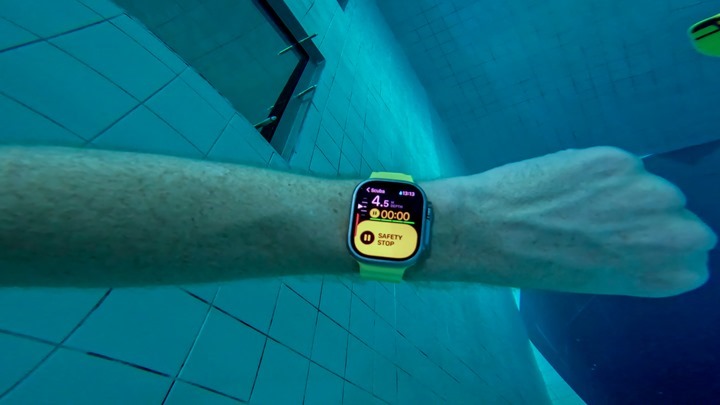
The Garmin was identical here too, both in terms of when it triggered the automatic safety stop, as well as when timing. I don’t remember hearing an audible safety clearance alert from the Apple Watch, but I do remember hearing one from the Garmin. It’s plausible I simply missed it.
With that, we meandered a bit more around in the shallows for a few minutes as we came up. I mean, why not take pictures in a cool place like this?

There were even water spin bikes here, in case I really wanted to get into things. Albeit, just don’t take a spin off the deep end:
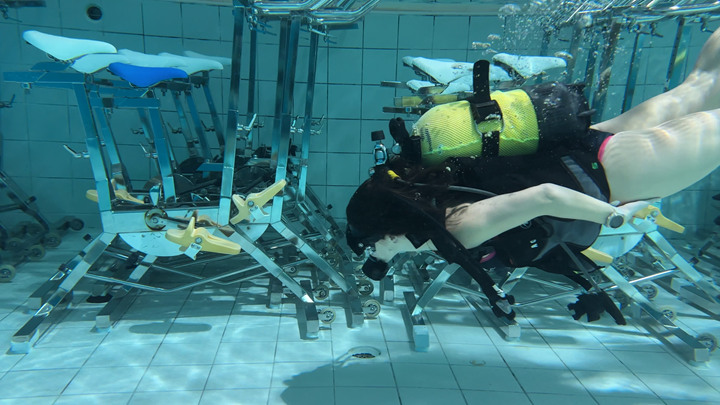
Once things were set, I surfaced up. Unfortunately, taking a few photos next to the spin bikes apparently triggered a 1-minute and 1-meter deep dive, removing my summary screen from the main dive. So I don’t have a picture of that on the watch. I’ve annoyingly seen the Garmin watch do the exact same thing outside on a real drift dive, while waiting for a boat pickup.
However, once out of the water, I could go back to the dive profile in the watch and see it there:
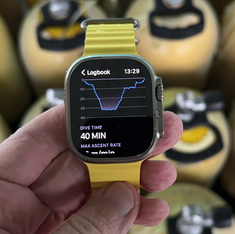
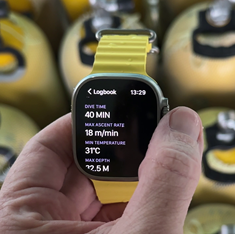

Of course, the whole point of using a fancy connected dive watch is to be able to have all of this end up in an electronic logbook of some sort. And it instantly does that here as well. I can crack open the Oceanic+ app, and then look at all the dive details there. Here’s that:
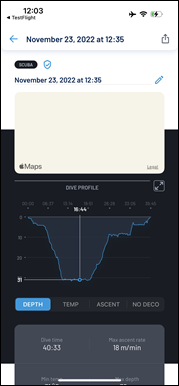
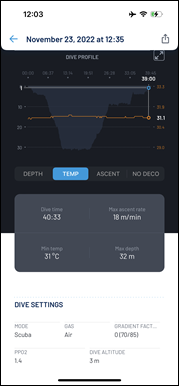
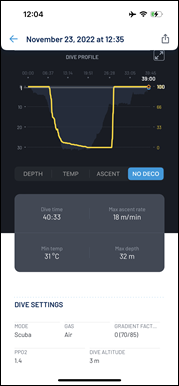
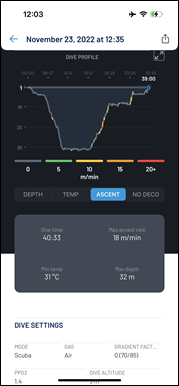
And there are also some notes sections down below that you can tweak too:
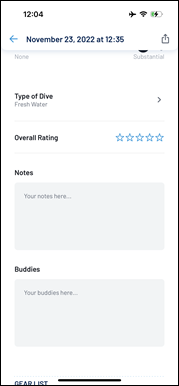
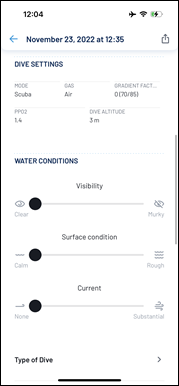
Finally, if you go in to your watch face, you can add watch face complications from the Oceanic+ app, these include, for example, your no-fly time (time remaining until flight), as well as time since last dive:
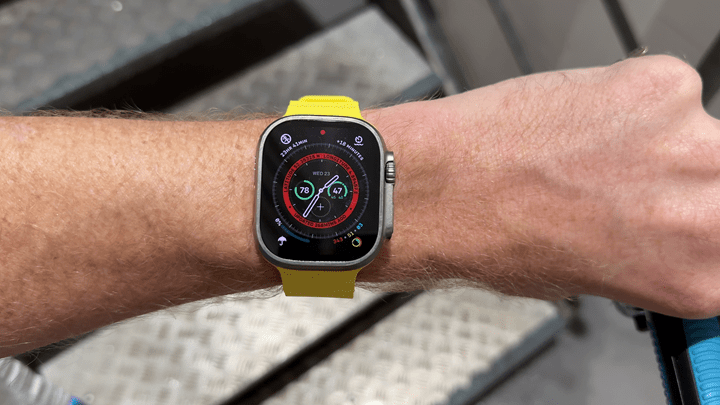
Ultimately, in terms of my dive experience, it all just worked, and worked fairly well. About the only complaint I’d have was that the digital crown underwater seemed a bit finicky in terms of over-spinning the data pages. Getting it exactly on the page I wanted was sometimes tricky. I’d imagine with gloves it’d be messier. It’s almost like the sensitivity was…well…too sensitive. But that’s a minor nit overall. Of course, I also wasn’t aiming to do something super complex with it either, in terms of a dive profile. But again, that’s not really the goal here.
Odds & Ends (an FAQ):
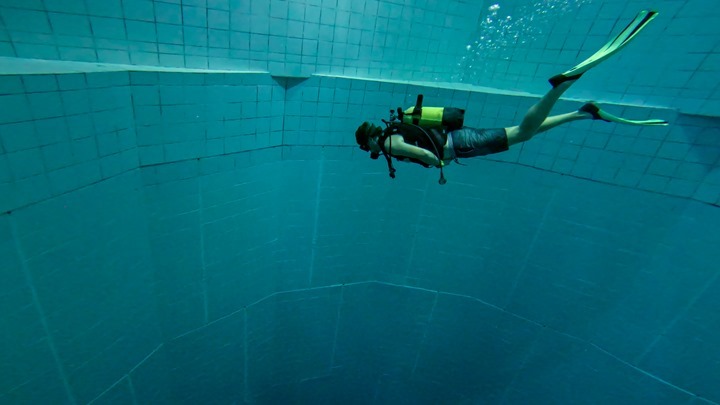
Next, there are lots of questions on how this all works in various scenarios. So think of this more as an FAQ than some sort of beautifully composed multi-paragraph short story. And what’s cool here is that I can take out my dive chamber to demonstrate a variety of things that would simply be impractical or too dangerous to do in real-life. Or, at a minimum, stupid to do in real-life. Here goes:
What happens if you exceed the depth?
Remember, there are two different ‘max’ values on the Apple Watch Ultra. The first is the hardware certification overall, which is for 100m deep. For 99% of people, that certainly won’t be an issue. The second is then the depth gauge, which is specified for 40m/130ft. You can see here I brought it to 42m/138ft. At which point it starts flashing the Max Depth warning:
![clip_image001[12] clip_image001[12]](http://media.dcrainmaker.com/images/2022/11/clip_image00112_thumb-2.jpg)
Keep in mind you’ll also get the warning if you go beyond whatever depth you set for that dive in the dive planner:
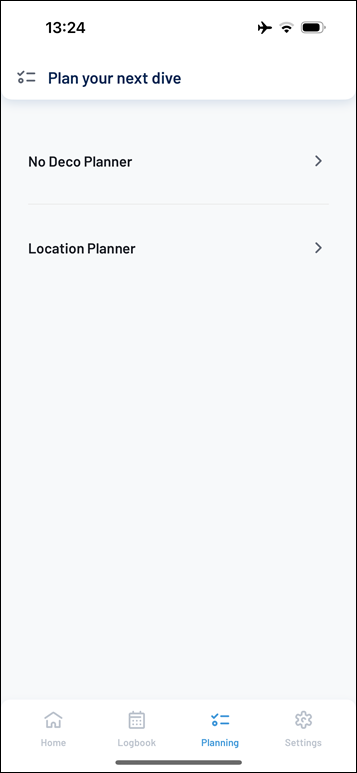
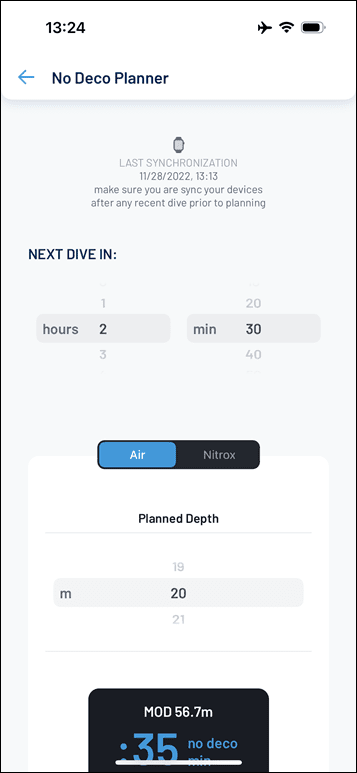
Beyond 44m/130ft, it’ll just show exceeded depth, and won’t show the real value anymore. Some might argue that a dive watch should always show the depth forever, even if you go too deep. And while the spirit of that seems laudable, in reality, every dive computer has maximum specifications. Apple is super clear the specification here is 40m/130ft, which is beyond a typical PADI Advanced Open Water certification level, and realistically, if you’ve found yourself that deep, you shouldn’t be there, and knowing you should go up is really the only thing that matters (which the unit brightly and unavoidably alerts you to).
What happens if you ascend too fast?
Ascending too fast is defined as greater than 30ft/9m per minute, in which case you’ll get an ascent rate warning. Here’s what that looks like in the chamber when I ascended like a rocket ship:
![clip_image001[14] clip_image001[14]](http://media.dcrainmaker.com/images/2022/11/clip_image00114_thumb.jpg)
Is there a free diving mode?
No, not today. Though, Oceanic has two things to say about this in their FAQ section:
“There is a snorkeling mode you can use to get depth and time underwater, which is available in the free version of the app. More advanced freedive features will be included in the future.”
…and…
“Not yet – check back soon for updates. There is a snorkeling mode you can use to get depth and time underwater. More advanced freedive features will be included in the future.”
So, seems like that’s on the way.
Does it write this data in any open way?
It depends a bit on how you define open, but yes, kinda. In addition to any data recorded by the Oceanic+ app, much of the core data is also written to Apple Health at various intervals. You can crack open Apple Health and see metrics like depth, water temp, and so on. The recording rate varies. In the case of water temp, it seems to be at anything from 10 minutes down to 1-minute intervals. Perhaps it triggers based on change of temp, it’s hard to know as both of my tests are in almost universally identical water temp (whereas outside the water temp would decrease as you go down).
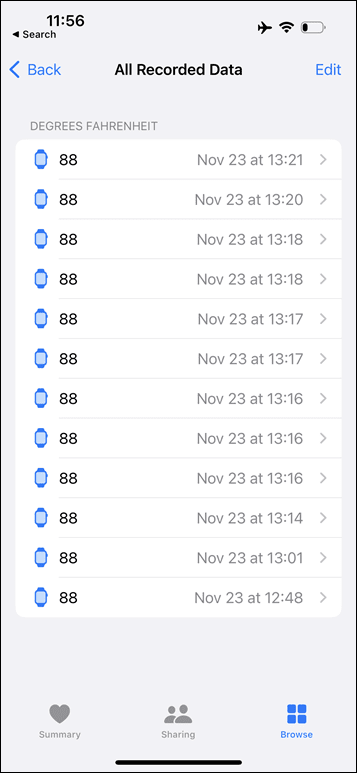
Meanwhile, water depth seems to be at roughly 2-3 second intervals. Again, this can be viewed as meters or feet, like any other metric.
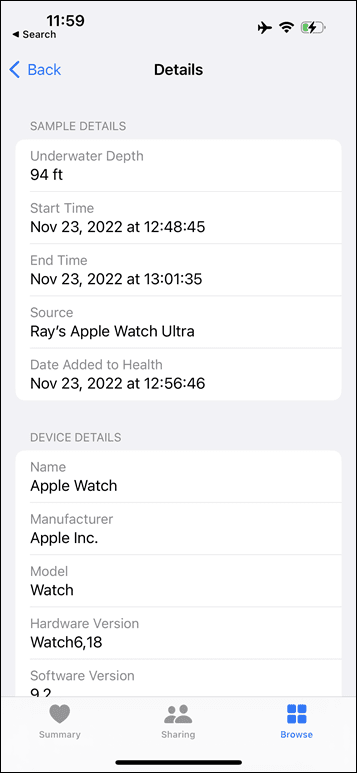
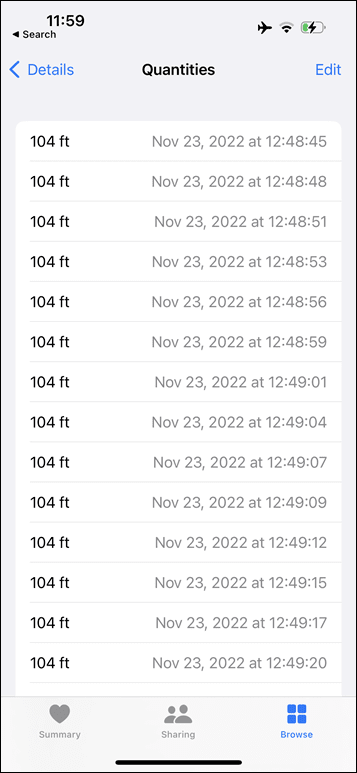
From there, any other app could consume this data and create nifty dive profiles. The source for this data is the Apple Watch hardware itself, not the Oceanic+ app. Meaning, the Apple Watch Ultra is recording and putting this data in Apple Health in the same manner as heart rate readings.
Wrap-Up:
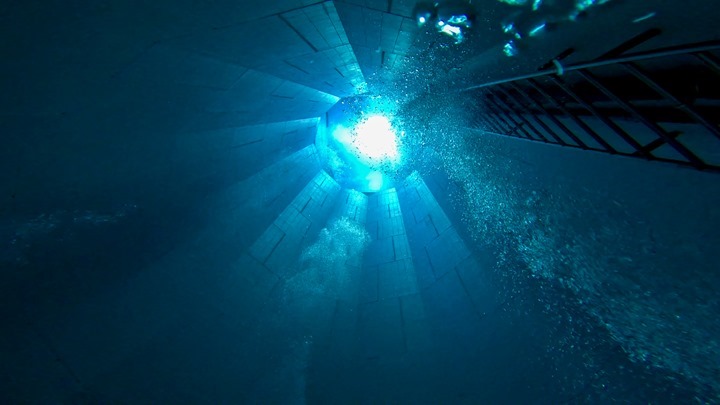
If you had told anyone just a few months prior to the Apple Watch Ultra launch, that Apple would make a dive watch – they’d mostly have laughed at you. Why would Apple go after such a relatively small market? Well, the same could be said about their also-announced plans for running power, even more niche by comparison. However, Apple didn’t exactly make a dive watch. They made a depth gauge that can be used by app makers as a dive watch. In theory, a dive watch includes all the bits that Oceanic+ brings to the table. Whereas Apple’s own ‘Depth’ app is merely a digital version of a standard depth gauge you’d find attached to a regulator. And just like that analog version, it lacks any safety-related features.
As for the Oceanic+ app, it’s a solid starting point, especially for casual divers. It includes everything pretty much any casual diver would need, and does it in a silly easy-to-use fashion. I mean, you literally just drop in the water and the app automatically starts. You don’t even need to press anything to use the app. During the dive, it dutifully let me know when it was time to head up, as well as would have alerted me had I ascended too fast. It also kept track of my safety stop and reminded me of that as I passed up through that depth.
The only thing missing for many divers that border more between ‘casual vacationer’ and ‘more frequent recreational’ is air integration. That’s a trickier nut to solve. In order to offer that, they’d need some sort of analog wireless transmission inside the Apple Watch Ultra. Digital transmissions like Bluetooth or WiFi simply don’t work underwater more than a few centimeters. Instead, companies have secondary modules that cost about $ 400 (for Garmin/Suunto/Oceanic modules), and then those transmit from the tank to the watch (via signals that work underwater). It’s plausible Apple already has communication modules inside the Apple Watch Ultra that could be leveraged with future or current external pods, but frankly, we won’t know till (or if) that ever happens.
For now though, the dive features on the Apple Watch Ultra do two things: They offer Apple Watch Ultra customers who dive casually an easy path to have dive information on their existing watch, without spending $ 500-$ 1,200 for that data. For people doing vacation dives, that’s awesome. Secondarily though, this applies significant pressure to other dive and endurance sports watch companies. For companies like Garmin, they have traditionally held this feature only in their dive watches, it virtually forces them to include diving/freediving features in something like a Fenix 8 series watch down the road. And for the legacy dive watch companies? Well, they’ll probably double down on both features related to technical diving, or try and figure out how to make their smartwatch offerings more appealing.
Either way, as always – competition is good. And that competition has certainly now arrived.
With that – thanks for reading!
Found This Post Useful? Support The Site!
At the end of the day, I’m an athlete just like you looking for the most detail possible on a new purchase. These posts generally take a lot of time to put together, so if you’re shopping for the Apple Watch Ultra (Ocean Band Yellow) or any other accessory items, please consider using the affiliate links below! As an Amazon Associate I earn from qualifying purchases. It doesn’t cost you anything extra, but your purchases help support this website a lot. Even more, if you use Backcountry.com or Competitive Cyclist with coupon code DCRAINMAKER, first time users save 15% on applicable products!
And of course – you can always sign-up to be a DCR Supporter! That gets you an ad-free DCR, access to the DCR Quarantine Corner video series packed with behind the scenes tidbits…and it also makes you awesome. And being awesome is what it’s all about!


